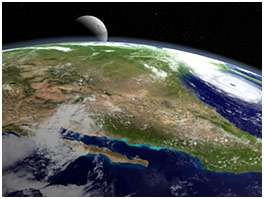New World post-pandemic reforestation helped start Little Ice Age, say Stanford scientists

The power of viruses is well documented in human history. Swarms of little viral Davids have repeatedly laid low the great Goliaths of human civilization, most famously in the devastating pandemics that swept the New World during European conquest and settlement.
In recent years, there has been growing evidence for the hypothesis that the effect of the pandemics in the Americas wasn't confined to killing indigenous peoples. Global climate appears to have been altered as well.
Stanford University researchers have conducted a comprehensive analysis of data detailing the amount of charcoal contained in soils and lake sediments at the sites of both pre-Columbian population centers in the Americas and in sparsely populated surrounding regions. They concluded that reforestation of agricultural lands-abandoned as the population collapsed-pulled so much carbon out of the atmosphere that it helped trigger a period of global cooling, at its most intense from approximately 1500 to 1750, known as the Little Ice Age.
"We estimate that the amount of carbon sequestered in the growing forests was about 10 to 50 percent of the total carbon that would have needed to come out of the atmosphere and oceans at that time to account for the observed changes in carbon dioxide concentrations," said Richard Nevle, visiting scholar in the Department of Geological and Environmental Sciences at Stanford. Nevle and Dennis Bird, professor in geological and environmental sciences, presented their study at the annual meeting of the American Geophysical Union on Dec. 17, 2008.
Nevle and Bird synthesized published data from charcoal records from 15 sediment cores extracted from lakes, soil samples from 17 population centers and 18 sites from the surrounding areas in Central and South America. They examined samples dating back 5,000 years.
What they found was a record of slowly increasing charcoal deposits, indicating increasing burning of forestland to convert it to cropland, as agricultural practices spread among the human population-until around 500 years ago: At that point, there was a precipitous drop in the amount of charcoal in the samples, coinciding with the precipitous drop in the human population in the Americas.
To verify their results, they checked their fire histories based on the charcoal data against records of carbon dioxide concentrations and carbon isotope ratios that were available.
"We looked at ice cores and tropical sponge records, which give us reliable proxies for the carbon isotope composition of atmospheric carbon dioxide. And it jumped out at us right away," Nevle said. "We saw a conspicuous increase in the isotope ratio of heavy carbon to light carbon. That gave us a sense that maybe we were looking at the right thing, because that is exactly what you would expect from reforestation."
During photosynthesis, plants prefer carbon dioxide containing the lighter isotope of carbon. Thus a massive reforestation event would not only decrease the amount of carbon dioxide in the atmosphere, but would also leave carbon dioxide in the atmosphere that was enriched in the heavy carbon isotope.
Other theories have been proposed to account for the cooling at the time of the Little Ice Age, as well as the anomalies in the concentration and carbon isotope ratios of atmospheric carbon dioxide associated with that period.
Variations in the amount of sunlight striking the Earth, caused by a drop in sunspot activity, could also be a factor in cooling down the globe, as could a flurry of volcanic activity in the late 16th century.
But the timing of these events doesn't fit with the observed onset of the carbon dioxide drop. These events don't begin until at least a century after carbon dioxide in the atmosphere began to decline and the ratio of heavy to light carbon isotopes in atmospheric carbon dioxide begins to increase.
Nevle and Bird don't attribute all of the cooling during the Little Ice Age to reforestation in the Americas.
"There are other causes at play," Nevle said. "But reforestation is certainly a first-order contributor."
Source: Stanford University




















